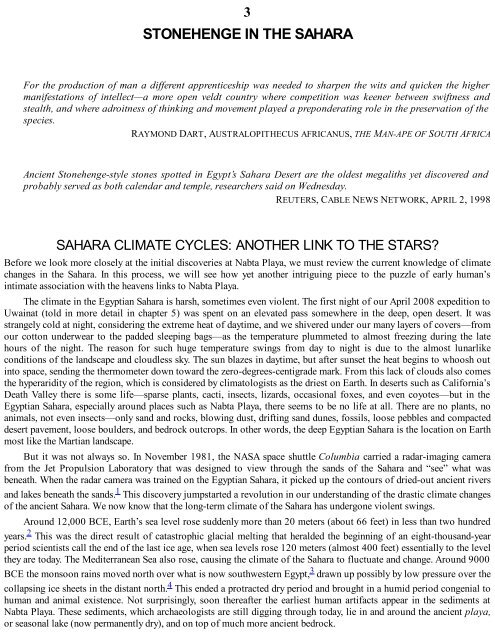Black Genesis: The Prehistoric Origins of Ancient Egypt
Black Genesis: The Prehistoric Origins of Ancient Egypt
Black Genesis: The Prehistoric Origins of Ancient Egypt
You also want an ePaper? Increase the reach of your titles
YUMPU automatically turns print PDFs into web optimized ePapers that Google loves.
3<br />
STONEHENGE IN THE SAHARA<br />
For the production <strong>of</strong> man a different apprenticeship was needed to sharpen the wits and quicken the higher<br />
manifestations <strong>of</strong> intellect—a more open veldt country where competition was keener between swiftness and<br />
stealth, and where adroitness <strong>of</strong> thinking and movement played a preponderating role in the preservation <strong>of</strong> the<br />
species.<br />
RAYMOND DART, AUSTRALOPITHECUS AFRICANUS, THE MAN-APE OF SOUTH AFRICA<br />
<strong>Ancient</strong> Stonehenge-style stones spotted in <strong>Egypt</strong>’s Sahara Desert are the oldest megaliths yet discovered and<br />
probably served as both calendar and temple, researchers said on Wednesday.<br />
REUTERS, CABLE NEWS NETWORK, APRIL 2, 1998<br />
SAHARA CLIMATE CYCLES: ANOTHER LINK TO THE STARS?<br />
Before we look more closely at the initial discoveries at Nabta Playa, we must review the current knowledge <strong>of</strong> climate<br />
changes in the Sahara. In this process, we will see how yet another intriguing piece to the puzzle <strong>of</strong> early human’s<br />
intimate association with the heavens links to Nabta Playa.<br />
<strong>The</strong> climate in the <strong>Egypt</strong>ian Sahara is harsh, sometimes even violent. <strong>The</strong> first night <strong>of</strong> our April 2008 expedition to<br />
Uwainat (told in more detail in chapter 5) was spent on an elevated pass somewhere in the deep, open desert. It was<br />
strangely cold at night, considering the extreme heat <strong>of</strong> daytime, and we shivered under our many layers <strong>of</strong> covers—from<br />
our cotton underwear to the padded sleeping bags—as the temperature plummeted to almost freezing during the late<br />
hours <strong>of</strong> the night. <strong>The</strong> reason for such huge temperature swings from day to night is due to the almost lunarlike<br />
conditions <strong>of</strong> the landscape and cloudless sky. <strong>The</strong> sun blazes in daytime, but after sunset the heat begins to whoosh out<br />
into space, sending the thermometer down toward the zero-degrees-centigrade mark. From this lack <strong>of</strong> clouds also comes<br />
the hyperaridity <strong>of</strong> the region, which is considered by climatologists as the driest on Earth. In deserts such as California’s<br />
Death Valley there is some life—sparse plants, cacti, insects, lizards, occasional foxes, and even coyotes—but in the<br />
<strong>Egypt</strong>ian Sahara, especially around places such as Nabta Playa, there seems to be no life at all. <strong>The</strong>re are no plants, no<br />
animals, not even insects—only sand and rocks, blowing dust, drifting sand dunes, fossils, loose pebbles and compacted<br />
desert pavement, loose boulders, and bedrock outcrops. In other words, the deep <strong>Egypt</strong>ian Sahara is the location on Earth<br />
most like the Martian landscape.<br />
But it was not always so. In November 1981, the NASA space shuttle Columbia carried a radar-imaging camera<br />
from the Jet Propulsion Laboratory that was designed to view through the sands <strong>of</strong> the Sahara and “see” what was<br />
beneath. When the radar camera was trained on the <strong>Egypt</strong>ian Sahara, it picked up the contours <strong>of</strong> dried-out ancient rivers<br />
and lakes beneath the sands. 1 This discovery jumpstarted a revolution in our understanding <strong>of</strong> the drastic climate changes<br />
<strong>of</strong> the ancient Sahara. We now know that the long-term climate <strong>of</strong> the Sahara has undergone violent swings.<br />
Around 12,000 BCE, Earth’s sea level rose suddenly more than 20 meters (about 66 feet) in less than two hundred<br />
years. 2 This was the direct result <strong>of</strong> catastrophic glacial melting that heralded the beginning <strong>of</strong> an eight-thousand-year<br />
period scientists call the end <strong>of</strong> the last ice age, when sea levels rose 120 meters (almost 400 feet) essentially to the level<br />
they are today. <strong>The</strong> Mediterranean Sea also rose, causing the climate <strong>of</strong> the Sahara to fluctuate and change. Around 9000<br />
BCE the monsoon rains moved north over what is now southwestern <strong>Egypt</strong>, 3 drawn up possibly by low pressure over the<br />
collapsing ice sheets in the distant north. 4 This ended a protracted dry period and brought in a humid period congenial to<br />
human and animal existence. Not surprisingly, soon thereafter the earliest human artifacts appear in the sediments at<br />
Nabta Playa. <strong>The</strong>se sediments, which archaeologists are still digging through today, lie in and around the ancient playa,<br />
or seasonal lake (now permanently dry), and on top <strong>of</strong> much more ancient bedrock.


